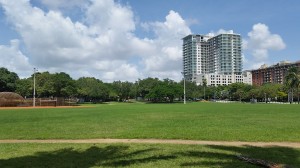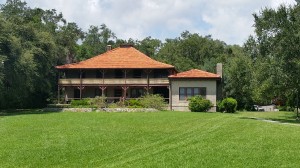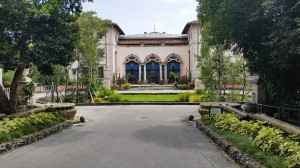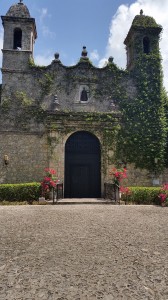Posted September 29, 2014
By GABE IBRAHIM
Driving through Coconut Grove on a Thursday night would lead most visitors to think the neighborhood exemplifies the Miami they always hear about: A wild city that comes alive for parties and a place worth going to only for the nightlife and beaches.
But once the party ends and the crowd of mainly college students leaves, the Grove takes on a much different persona.
The neighborhood becomes a tranquil spot to eat and shop, a quiet place among the sea of noise in Miami. It offers not only a quiet oasis in one of America’s largest cities, but also one of the best places to take in the history of South Florida.

Map of Coconut Grove in the 1890s (Map courtesy of Rollins College).
The Grove’s history goes back to the early 1800s and still offers remnants from its first residents.
To understand why the history of Coconut Grove is worth knowing, one must understand what South Florida was just before the turn of the century.
With no railroad or roads, the area around Biscayne Bay was one of the nation’s most isolated places. Visitors would have to travel past it to Key West on bigger ships, just to change ships and navigate the shallow, unknown bay waters near the coast.
So many ships wrecked on this journey that many early residents made money off salvaging these wrecks. The peril and length of the journey had one major effect: only the best sailors and/or the richest travelers made it to the area now known as Miami from the North.
In turn, what remains of these early residents of Miami gives us an idea of how they lived and, more importantly, why they came.
Barnacle State Park ranger James Pate said these places are “monuments to these people trying to get away from it all.”
Visiting the attractions there gives you a good sense that, while times have changed, the reasons for living in Miami really haven’t. Coconut Grove, or simply the Grove, takes up about five square miles of Biscayne Bay’s coast just east of Coral Gables and south of Brickell.
The Grove’s story begins in 1825 when the Cape Florida lighthouse opened and brought visitors to the area. It would be almost 50 years before Coconut Grove got its official name from a post office opened by Dr. Horace P. Porter. Porter only lived in the area for a year, but the name stuck as snowbirds from the Northeastern United States and immigrants from Britain made residence there.
Two of these British immigrants, Isabella and Charles Peacock, built the first hotel in South Florida on the shore of Biscayne Bay in 1883. The location, where the Peacock Inn stood until 1926, was turned into Peacock Park by the City of Miami in 1934. The park is rather unspectacular with a baseball field and a playground for children, but a boardwalk that juts into Biscayne Bay beyond the baseball field is definitely worth seeing.

Peacock park commemorates where the Peacocks built the first hotel on mainland South Florida (Photo by Gabriel Ibrahim).
The park’s location is within view of the Grove’s central shopping and dining center, CocoWalk, as well as being walking distance to a trio of popular restaurants on the bay: Scottie’s Landing, Monty’s Raw Bar, and The Chart House.
The park’s more recent history includes hippies setting up shop there in the 1960s and the Mutiny Club across the street bringing cocaine kingpins to its grounds in the 1980s.
The Peacock Inn brought with it employment opportunities for Bahamian immigrants that were in Key West. As they began to take jobs at the Inn, they settled on Charles Avenue and created mainland South Florida’s first black community. If you’re coming from Downtown Miami or Coral Gables on South Dixie Highway, Charles Avenue is good for a drive through during the day.
First, you pass the eerie Historic Coconut Grove cemetery with its early 20th century graves and slightly overgrown plants.
The drive takes you by many shotgun houses, tiny churches and concludes at the Coconut Grove Playhouse. The Playhouse, abandoned in 2006, housed many prominent events and guests including Marilyn Monroe and Dave Letterman’s last show outside New York.
Visitors cannot enter the playhouse, but walking around back offers a chance to see posters and advertisements from the 1930s to the 1990s that were left behind. Charles Avenue also gives a stark reminder to the separation between the poor, mainly black workers in the Grove and its rich residents and visitors. The dichotomy still exists today, as a drive through Grand Avenue’s dilapidated structures to Coco Walk’s grandeur will plainly exhibit.
After driving along Charles Avenue, making a left on Main Highway towards Coco Walk brings you to one of the best landmarks in South Florida, the Barnacle State Park.
The park celebrates the home of Ralph Middleton Monroe, one of South Florida’s most prominent early residents. He first came to Miami in 1877 on the advice of William Brickell, whose sloop Munroe rescued off the coast of Staten Island. He built a relationship with another major South Florida family, the Peacocks and was actually the person who first suggested that they build an inn.

Ralph M. Munroe’s home is the oldest home in its original location in Miami-Dade County (Photo by Gabriel Ibrahim).
Munroe relocated to Coconut Grove permanently in 1886 and bought 400 acres of land on Biscayne Bay for $400 and one of his yachts.
He founded the Biscayne Bay Yacht Club the following year, earning him the title of Commodore. In 1891, he moved into his main house from a small boathouse on the property. The house is the oldest home in Miami-Dade County still standing in its original location and, as Ranger James Pate puts it, “one of the strongest ties we have to the people in South Florida 120 years ago.”
The park consists of the house, the boathouse and five acres of land around it. The large track of land offers an escape from Miami’s urban life.
“The sense of serenity makes this place an oasis near one of the biggest cities in the world,” Pate said. “You can hardly hear anything but the rustling of wind through the trees.”
The house itself is a testament to the ingenuity and will power of Munroe. He originally built a one-story house, but desired a second floor in 1908. To keep the roof he built in tact, Munroe bought railroad parts from Henry Flagler and raised the first floor up to put the second floor underneath. He also pioneered the use of breakaway walls in both the main house and boathouse to combat hurricanes, a practice now enforced by the state of Florida.
Entrance to the park costs just $2 and another $3 is required to enter the Main House, an experience that Pate says is well worth it.
“A lot of people skip the house, but they miss out on an amazing feat of architecture and a great picture of life in Miami in the early 20th century,” Pate explained.
The crown jewel of any historical trip through Coconut Grove lies seven minutes northeast of CocoWalk and the other attractions.
The Vizcaya Museum and Gardens stands at the intersection of 32nd Avenue and Miami Avenue on the bay’s shore. Villa Vizcaya was the former winter residence of James Deering, an early 20th century executive of International Harvester.
Starting in 1910, Deering used his earnings from the largest producer of agricultural machinery in the USA to purchase 180 acres of land in Miami. Deering, with the help of artistic director Paul Chalfin, made his vision of an 16th century Italian villa come to life in South Florida.
Vizcaya’s curator, Gina Wouters, explained why she finds the home so interesting.
“Vizcaya is a 20th Century creation that has maintained its owner’s fantasy of being of another time and place,” Wouters said.

The entrance to Vizcaya is the first step into a different time that James Deering created in making his winter home (Photo by Gabriel Ibrahim).
The anachronistic feeling that Deering strove for is exactly how visitors feel seeing the estate for the first time.
The outer façade is reminiscent of villas from the Italian Renaissance with two large columns and perfect symmetry. It also has rich decoration and strong curves giving it Baroque qualities as well.
The outside gives a preview of the rich mix of culture and history inside the building. Deering spent years acquiring important artworks from around Europe. He and Chalfin adorned almost every spot in Vizcaya with these pieces. Yet, the differing styles come together in unique cohesiveness.
“Artistic styles range from the Renaissance to 20th Century American Modernism and all in between,” Wouters said. “Every aspect is united through Chalfin’s bigger design aesthetic for the house.”
The gardens outside are wonderful for a romantic walk or to see any plant you can imagine. They also offer further mixture of cultures and arts as Egyptian sphinxes statues stand next Victorian style gardens.
Suzy Trutie, director of Public Affairs for Vizcaya, pointed out another way Deering tried to blend South Florida with European style.
“Local stone, soil and plants reflect Deering’s desire to showcase Miami and its natural beauty,” Trutie said.
Be sure to check out Alice Wainwright Park next to the villa. Sitting on the tables on the bay while listening to the waves at Alice Wainwright might be the most relaxing thing to do in Miami.
Those four locations give you a good feel for the Grove’s history, but there are many more attractions to satisfy your historical taste. The most impressive, in my opinion, is a small church about two blocks away from the Barnacle on Main Highway.

Built by one man in one year, Plymouth Congregational Church is a hidden gem among the Grove’s many attractions (Photo by Gabriel Ibrahim).
The Plymouth Congregational Church is designed to look like an old mission church in Mexico and its front door dates back 375 years to a monastery in the Pyrenees Mountains of Spain. The chapel looks beautiful and would make for a great wedding location, but the impressive part is that Felix Rebon built it by himself in one year.
Near Plymouth Church, two preparatory schools have historically significant architectural feats: Ransom Everglades’s “Pagoda” and “El Jardin” at Carrollton School of the Sacred Heart.
Both give interesting perspectives on early 20th century architecture and specifically how northern architects applied their theories to South Florida.
Miami City Hall, next to Peacock Park, currently occupies a large part of Dinner Key. Before City Hall took its roots on Dinner Key, Pan American Airlines had the world’s largest seaplane center there until World War II. During the war, the terminals served as a United States naval base before new airports in South America limited the usefulness of seaplanes. City Hall is actually the converted Pan Am Terminal.
If You Go
Vizcaya
- Open every day 9:30 p.m-4:30 p.m. except Tuesdays, Thanksgiving and Christmas Day
- Cost; Adults: $18, seniors: $12, students: $10, children 6-12: $6, children under 5: free
- 3251 S. Miami Ave., Miami, Fla. 33129
The Barnacle Historic State Park
- Open 9 a.m.-5 p.m. every day except Tuesdays, New Year’s, Thanksgiving, and Christmas
- Tours every day at 10 a.m., 11:30 a.m., 1 p.m., and 2:30 p.m.
- Admission fee: $2 per person (must have exact change)
- Museum tour fee: $3 per adult, $1 per child ages 6-12, free for children 5 and younger
- 3485 Main Highway, Coconut Grove, Fla. 33133
Plymouth Congregational Church
- Services are held at 10 a.m. each Sunday
- 3400 Devon Road, Miami, Fla. 33133
